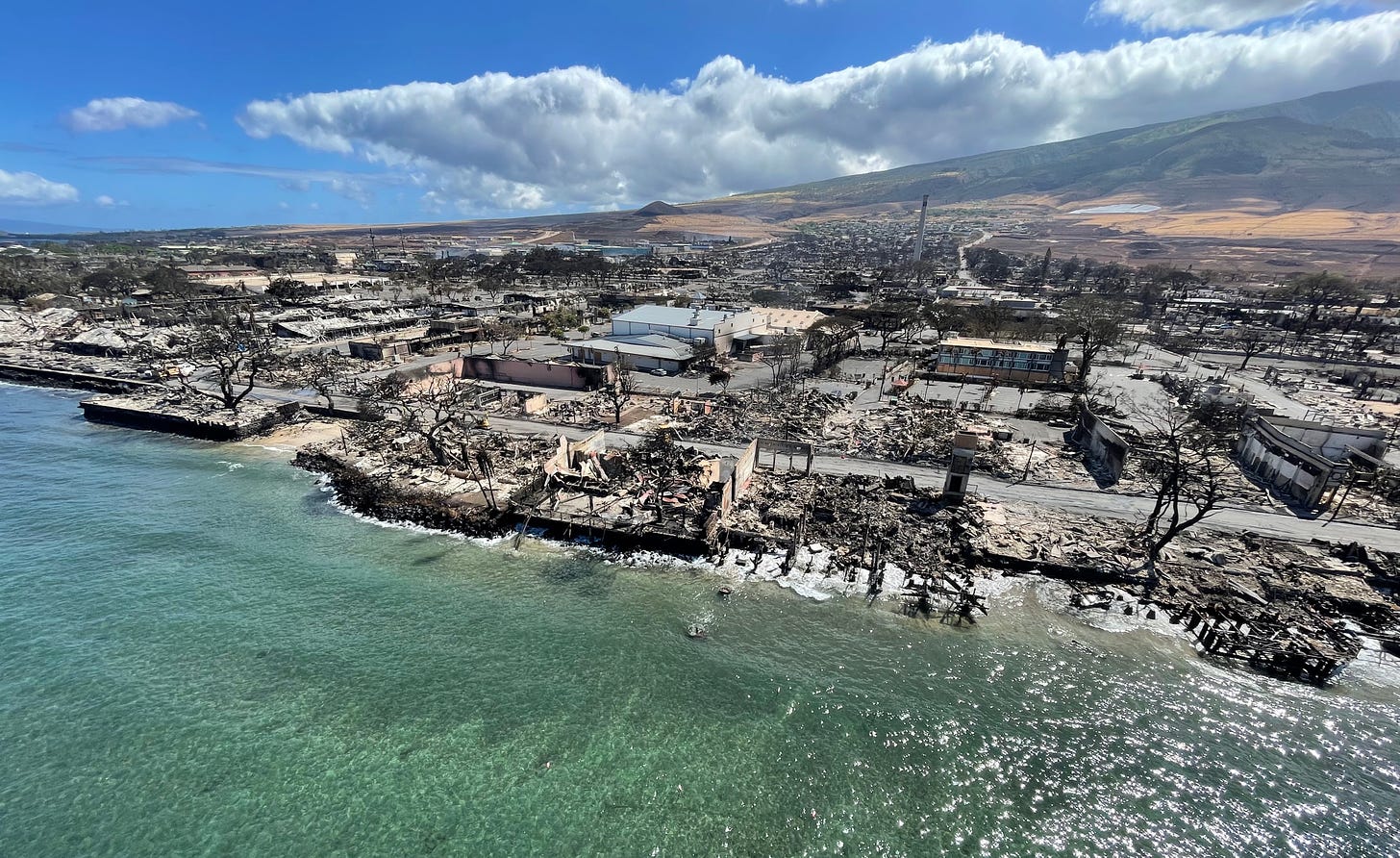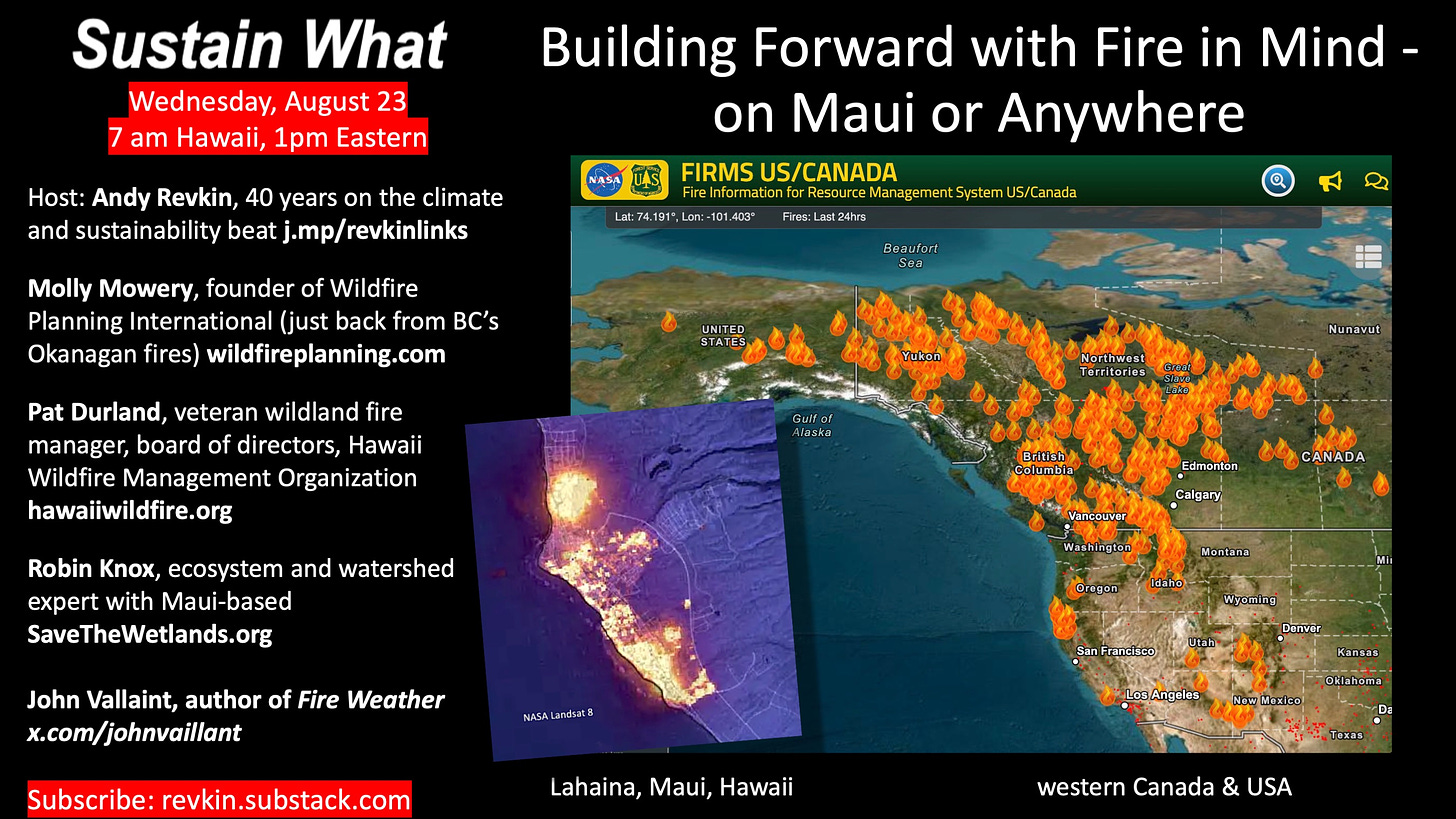Lessons for Everyone from Hawaii's Lahaina Fire Tragedy
From Boulder County, Colorado, to Lahaina, Hawaii, to West Kelowna, B.C. a tragically familiar tale of unheeded wildfire warnings. Here's a conversation with top experts trying to change this pattern.
UPDATED 8/24 - Watch and share this Sustain What episode on building “firewise” futures after this summer of combustion. It was full of invaluable insights contributed by several great guides to reducing wildfire risk facing landscape change, climate change and community inertia. Watch on YouTube below, Facebook, LinkedIn or X/Twitter (@revkin). A rough transcript can be sifted here via Trint (if more folks financially support Sustain What, I can hire a copy editor).
“Wildfire threats are imminent and can have widespread damage that potentially affects all properties within Western Maui.”
That was the opening line of a summary of a 2014 report published by the Hawaii Wildfire Management Organization, a nonprofit group working with governments to foster proactive fire preparedness and responses.
An invaluable Wall Street Journal article on the Maui disaster focused on this decade-old, largely unheeded warning, with wrenching input from Elizaeth Pickett, the executive director of the Hawaii wildfire group: Hawaii Officials Were Warned Years Ago That Maui’s Lahaina Faced High Wildfire Risk.
“We’ve been hammering this home, and it’s just really frustrating and heartbreaking to see that some things could have been done, but we couldn’t find money,” she said. “We are living through what happens when there’s a lag and everyone’s still catching up.”
Hawaii Governor Josh Green used news conferences to stress the uniqueness of the urban conflagration sparked by a wildfire and the novelty of winds from a tropical cyclone, Hurricane Dora, passing so far away (more than 800 miles to the south).
But the reporters, Dan Frosch and Jim Carlton, dug in, reporting:
"The fire danger from passing hurricanes in Hawaii was documented in a 2020 report by researchers at the University of Hawaii and the East-West Center, which tied a 2018 outbreak of fires on both Maui and Oahu to winds from Hurricane Lane. Like Hurricane Dora, Hurricane Lane passed the islands to the south, but sparked four fires—three on West Maui and one on Oahu—which blackened about 3,000 acres.
The extreme fire firestorm in a town downwind of sweeping expanses of open land cloaked in highly combustible non-native grasses after big-agriculture moved out should have been no surprise, either.
This disaster is a haunting echo of the mix of events and conditions that led to the devastating urban impacts of the Marshall Fire in Boulder County, Colorado in December 2021. I reported extensively on the factors that contributed to the destruction of more than a thousand homes and businesses - one being the lack of wildfire-centered building codes in municipalities like Superior and Louisville that didn’t have to abide by the strict county wildfire-resistant building code.
There’s much, much more to assess in Hawaii’s calamity, and a huge amount of helpful reporting has been done. I’ve posted just a couple of article links below.
At the moment I’m going to widen the view from Maui to include Canada’s astonishingly off-the-charts fire year and to review insights, tools and tactics of experts working to shift communities to “firewise” living.
Join me today at 1 p.m. U.S. Eastern time, 7 a.m. in Hawai’i, for a special pop-up Sustain What conversation, as I mentioned above. Here are the details:
Building Forward With Fire in Mind - on Maui or Anywhere
Around the world in far too many places, a mix of landscape change, climate change and societal exposure and vulnerability is building an era of megafires and mega impacts.
My guests have invaluable perspectives.
- Molly Mowery is the executive director of the Community Wildfire Planning Center and is just back from several weeks of work amid British Columbia’s Okanagan fires.
- Pat Durland, a veteran wildland fire manager, is on the board of directors of the nonprofit Hawaii Wildfire Management Organization, which in 2014 published the hauntingly prescient Community Wildfire Protection Plan for West Maui that is now a sobering read. Learn more at http://hawaiiwildfire.org.
- Robin Knox is an ecosystem and watershed expert with the Maui-based nonprofit Save the Wetlands, a group that is part of a widening coalition pressing to be sure Lahaina, which was devastated on August 8, is rebuilt with fire, ecology, water and respect for indigenous history and rights in mind.
- John Vallaint is the author of Fire Weather - A True Story from a Hotter World, a riveting account of the Fort McMurray firestorm of 2016 and the wider issues facing communities in what forest historian Stephen Pyne calls the “Pyrocene” age.
Watch and then weigh in here!
Read my relevant coverage of communities facing massive fire risk.
More relevant reading:
A terrifying fire struck Maui in 2018. Officials were warned of a repeat. (Washington Post)
Maui’s deadly wildfires burn through Lahaina – it’s a reminder of the growing risk to communities that once seemed safe (The Conversation, Mojtaba Sadegh Associate Professor of Civil Engineering, Boise State University)
[W]hile commentators often blame the rising risk on homebuilders pushing deeper into the wildland areas, we found that the population growth in these high-risk areas explained only a small part of the increase in the number of people who were exposed to wildfires. Instead, three-quarters of this trend was driven by intense fires growing out of control and encroaching on existing communities.
Cities Aren’t Supposed to Burn Like This Anymore—Especially Lahaina (Wired, Matt Simon)
Also, if you got this far, here’s a link to a stupid Twitter moment of mine amid the Lahaina fire coverage that’s worth reviewing soon.
Stay cool and effective.
And do chip in if you want to help sustain this Sustain What project:







Parts of Marshall Fire that weren't covered much in the press that I saw;
Evacuation successful due to lots of cars (against narrative "no one should have private vehicles"
Houses burned because they were too close together (densification is great!)
Lots of tall dry grasses (cows are bad! Leaving grass alone is great).
And bad luck..
too many ignitions at the same time,
it snowed the next day.
The survival of the 81-year-old "Miracle House" is striking. Owners cut back undergrowth on the property, had a five-foot stone and gravel buffer around the house, and a metal roof. Virtually untouched!
There is a sad echo of CA as well. Hawaiian Electric was forced to spend money on renewable generation rather than upgrading infrastructure. Result: Wind and debris downed lines that sparked (sorry about the bad pun) the fires. Same thing happened in CA.